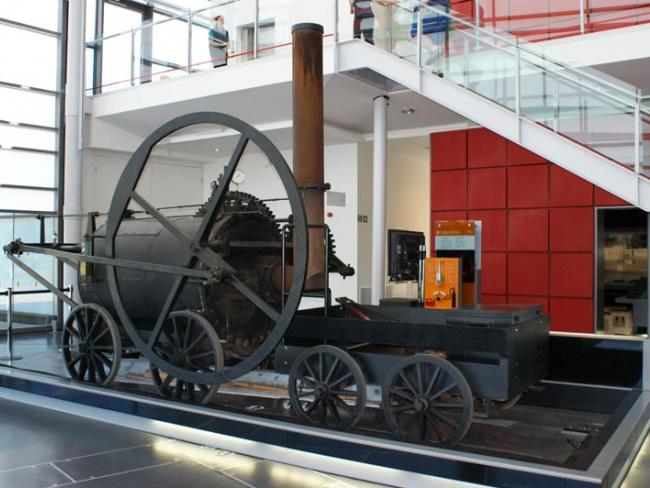
A replica of Richard Trevithick’s 1804 Pen y Darren locomotive, on display in the National Waterfront Museum, Swansea. The museum notes that, like the original, it broke the rails on which it was set! Photo Hugh Llewelyn via Flickr CC BY-SA 2.0 .
This year marks the bicentenary of the opening of the Stockton & Darlington Railway. It will rightly be celebrated with events throughout the year…
In the early nineteenth century roads were poor, little more than tracks. Transport, especially for freight, was difficult and most easily accomplished by water, a slow form of transport.
Railways, first in Britain and then across much of the world, were crucial to developing the industrial revolution, capitalism – and a working class.
They carried coal from mines to where industry needed it for fuel. Electricity was generated at power stations and gas was made at gasworks, both fed by coal carried largely by trains. Rail moved most of the raw materials needed by industry, and transported most of the finished goods to where they were needed.
Trains allowed people to move easily from the country to the cities and towns, to take up jobs in industry. And rail carried the food needed to feed the population of these rapidly expanding towns and cities.
The new railways helped to spread new ideas, through easier distribution of books and newspapers. The needs of the railways boosted the development of the electric telegraph as instant communication was vital to the safe and efficient operation of trains. And the electric telegraph soon became the principal means of transmitting important messages and information over long distances for all purposes.
Steam power was integral to the development of railways. The first steam engines, used for pumping water from mines, had been designed and built in Britain in the early part of the eighteenth century. Later that century, James Watt developed steam engines to power machinery.
Cornish mining engineer Richard Trevithick designed a high-pressure steam locomotive – a self-propelled engine – in 1804 for an early Welsh industrial railway. This was not successful due to the fragile cast iron track on which it ran, but the idea stuck. In 1812, the Middleton Railway in Leeds was the first to successfully use steam locomotives to haul trains.
Britain’s railway industry is promoting 2025 as the 200th anniversary of the birth of the modern railway. But it’s arguable that the opening of the Liverpool & Manchester Railway in 1830 – the world’s first inter-city railway – was the true dawn of the modern railway.
The Rocket
The Stockton & Darlington Railway opened in September 1825. The company’s first engineer, George Stephenson, took railways beyond a primitive waggon way. A little later, in 1829, he won a competition with the famous Rocket at the Rainhill Trials run by the Liverpool & Manchester Railway. As a result, the company decided from the outset to use steam locomotives for its trains.
The new capitalists created by the Industrial Revolution were making huge profits from the exploitation of their workers. The success of the Liverpool & Manchester Railway led directly to a massive boom in railway building as those profits were invested to make still greater profits. Within fifty years a vast network of railways criss-crossed the country.
‘It wasn’t long before discussions began about the need to plan the railways, run for the benefit of the nation, and publicly owned…’
The railway companies went on to build ports for the export and import of goods, and they built large numbers of hotels to meet the massively increased demand for travel. Railway-owned ferries connected Britain with neighbouring countries, and connected towns and cities on lakes and rivers with the nearest railhead. As roads improved, they developed bus networks and road haulage.
Hundreds of thousands of workers were employed in railway-owned activities, many highly skilled. They soon organised effective trade unions to fight for safety, pay and better conditions.
But the commercial failure of duplicated rail routes meant that it wasn’t long before discussions began about the need to plan the railways, run for the benefit of the nation, and publicly owned. By the First World War, all of the unions advocated nationalisation. The owners fiercely resisted.
The rot
Profits declined from the 1930s as roads improved, and cars and lorries became far more numerous. Eventually nationalisation happened in 1948, but did nothing to stop the rot. The dominance of road transport led to the massive rail cutbacks of the 1960s, in particular following the infamous Beeching Report of 1963.
British Rail managed decline until the 1980s, but started to turn things around as passenger numbers began to bounce back. By then the Thatcher government was contemplating the return of railways to the private sector.
Peripheral activities had already been hived off, and in 1994 the government started fragmenting an integrated core railway – then selling it off.
Privatisation was dealt a massive blow in 2001. The private infrastructure owner Railtrack went bankrupt following serious derailments. Publicly owned Network Rail took over. But the fragmented passenger services have staggered on for more than twenty years before a government has been forced into taking at least some action to address the industry’s problems.
While Britain’s rail network is now much smaller than it was and the volume of freight a tiny fraction of what it once carried, the number of passenger journeys made by train is now at near record levels and growing.
It is a vital part of the nation’s public transport system and the current construction of HS2 designed for trains travelling over 200 mph, along with the reintegration of passenger services, could take the railway into a bright new future.
